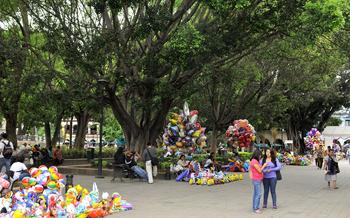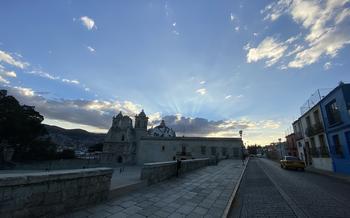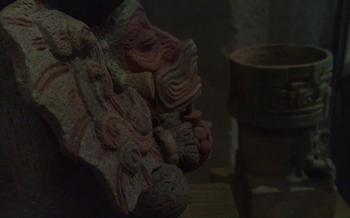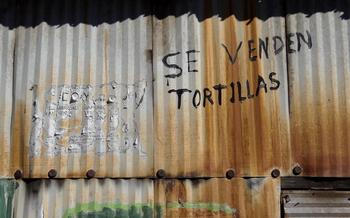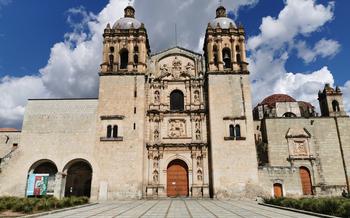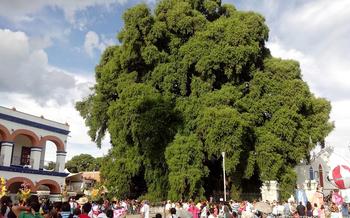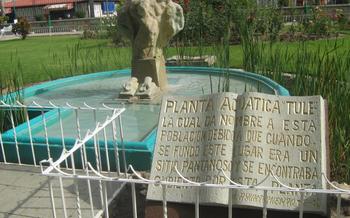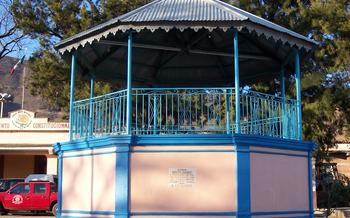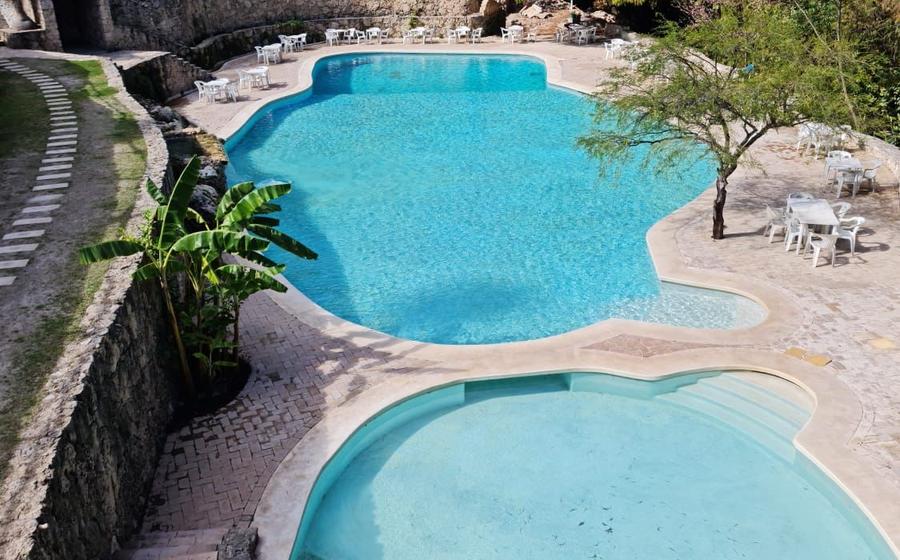
Calzada de la República
- Walking Tour
- Plaza de la Danza: A Stage for Cultural Expressions
- Templo de Santo Domingo de Guzmán
- Museo de las Culturas de Oaxaca (MACO)
- Museo Textil de Oaxaca (MTO)
- Cerro del Fortín: A Panoramic Paradise and Historical Landmark
- Paseo Juárez "El Llano"
- Botanical Garden
- A Haven of Biodiversity
- Insider Tip:
Walking Tour
A leisurely stroll along the Calzada de la República is a fantastic way to experience its charm and historical significance. The walk typically spans around 5 kilometers and takes approximately 1-2 hours, depending on your pace and the number of stops you make along the way. Starting from the Plaza de la Danza, you can head east, admiring the impressive landmarks and points of interest that line the avenue. Notable must-sees include the Templo de Santo Domingo de Guzmán, the Museo de las Culturas de Oaxaca (MACO), and the Mercado de Benito Juárez.
As you wander, take time to appreciate the architectural details of the buildings, the vibrant street art, and the lively atmosphere that surrounds you. There are plenty of cafes, restaurants, and shops along the way, inviting you to stop for refreshments, souvenirs, or a bite to eat.
Plaza de la Danza: A Stage for Cultural Expressions
The Plaza de la Danza, located at the heart of Oaxaca City, serves as a vibrant stage for cultural expressions and traditional performances. Its profound significance lies in its representation of the indigenous heritage and rich cultural traditions of Oaxaca. The plaza is adorned with intricate mosaics depicting scenes from the history and mythology of the Zapotec and Mixtec civilizations, paying homage to the region's deep-rooted cultural identity.
At the center of the plaza stands the Fuente de las Ocho Regiones, a mesmerizing fountain adorned with sculptures representing the eight regions of Oaxaca. This captivating artwork symbolizes the unity and diversity of the state, showcasing the distinct cultures and traditions that converge within its borders.
The plaza comes alive during traditional dance performances, where groups of dancers clad in vibrant costumes showcase the mesmerizing footwork and graceful movements that have been passed down through generations. The energy and passion of these performances captivate audiences, offering a glimpse into the rich cultural tapestry of Oaxaca.
Among the most notable dances performed in the Plaza de la Danza is the Guelaguetza, an annual festival that celebrates the indigenous heritage of the region. This spectacular event features a kaleidoscope of colors, music, and dance, showcasing the unique traditions of each of Oaxaca's eight regions.
As you stroll through the Plaza de la Danza, be sure to take a moment to appreciate the intricate details of the surrounding architecture, which blends colonial and indigenous influences. Admire the carved stone facades, colorful tiles, and delicate arches that adorn the buildings lining the plaza, each telling a story of the city's rich history and cultural heritage.
Templo de Santo Domingo de Guzmán
The Templo de Santo Domingo de Guzmán is a magnificent example of Baroque architecture and a testament to the city's rich cultural heritage. Built in the 16th century by Dominican friars, the church boasts an impressive façade adorned with intricate carvings and sculptures depicting religious scenes and figures. The interior is equally stunning, with ornate altars, gold-leaf decorations, and breathtaking frescoes covering the walls and ceiling. These frescoes, painted by Miguel Cabrera, depict scenes from the life of Santo Domingo and the history of the Dominican Order.
The Templo de Santo Domingo de Guzmán holds a significant place in Oaxaca's history and culture. It was a center of religious and intellectual activity during the colonial period and played a crucial role in the city's development. Today, it continues to be a spiritual and cultural landmark, attracting visitors from around the world who come to admire its architectural beauty and historical significance.
In 1994, the Templo de Santo Domingo de Guzmán was designated a UNESCO World Heritage Site, recognizing its outstanding universal value. This prestigious designation highlights the church's importance as a cultural treasure and ensures its preservation for future generations.
Museo de las Culturas de Oaxaca (MACO)
The Museo de las Culturas de Oaxaca (MACO) is a must-see for anyone interested in the rich cultural heritage of Oaxaca. Housed in a former convent, the museum showcases a vast collection of pre-Hispanic artifacts, textiles, and contemporary art.
The museum's exhibits take visitors on a journey through the history and traditions of Oaxaca's indigenous cultures, from the Zapotecs and Mixtecs to the Mazatecs and Chinantecs. Highlights include a collection of intricately carved stone heads from the ancient city of Monte Albán, a display of traditional Zapotec textiles, and a room dedicated to the Day of the Dead, Oaxaca's most famous festival.
In addition to its permanent collection, MACO also hosts temporary exhibits, educational programs, and workshops. Visitors can learn about traditional weaving techniques, participate in cooking classes, or attend lectures on Oaxaca's history and culture.
Museo Textil de Oaxaca (MTO)
The Museo Textil de Oaxaca (MTO) is a vibrant celebration of the rich textile traditions of Oaxaca and Mexico. Nestled in the heart of the city, this museum showcases an impressive collection of traditional textiles from various indigenous communities across the region. Visitors are invited to explore the diverse weaving techniques, vibrant colors, and intricate patterns that have become synonymous with Oaxacan textiles.
The MTO's exhibits offer a glimpse into the cultural heritage and artistry of the indigenous Zapotec, Mixtec, and Mazatec peoples. Visitors can admire intricate bordados (embroideries), delicate huipiles (tunics), and colorful rebozos (shawls), each representing a unique community and its traditions. The museum also features workshops and demonstrations where visitors can learn about the weaving process and gain hands-on experience in creating their own textile masterpieces.
Beyond its educational value, the MTO plays a crucial role in preserving and promoting the cultural heritage of Oaxaca. By showcasing the artistry and craftsmanship of indigenous communities, the museum helps to ensure that these traditions continue to thrive and be appreciated by future generations.
Cerro del Fortín: A Panoramic Paradise and Historical Landmark
Amidst the vibrant tapestry of Oaxaca City, Cerro del Fortín stands as a majestic sentinel, offering breathtaking panoramic views that span the entire valley. Steeped in historical significance, this hilltop fortress once served as a strategic military stronghold, guarding the city from potential invaders. Today, it beckons visitors with its well-maintained hiking trails that wind through lush vegetation, leading to a summit that unveils an awe-inspiring vista.
The ascent to Cerro del Fortín presents a delightful challenge for outdoor enthusiasts, rewarding them with panoramic vistas that stretch for miles. The city of Oaxaca, with its terracotta rooftops and colonial architecture, sprawls beneath, while the surrounding mountains create a dramatic backdrop. The panoramic views from the summit offer a unique perspective of Oaxaca's geography and its rich cultural heritage.
Beyond its scenic allure, Cerro del Fortín holds historical significance as a former military fortress. During the colonial era, the Spanish constructed a fort on the hilltop to protect the city from potential attacks. The remains of this fort can still be seen today, adding to the site's historical charm.
Whether you seek a challenging hike, a breathtaking panorama, or a glimpse into Oaxaca's past, Cerro del Fortín promises an unforgettable experience. As you stand atop this hilltop sanctuary, you'll feel a sense of tranquility and awe, surrounded by the beauty of nature and the echoes of history.
Paseo Juárez "El Llano"
Amidst the enchanting streets of Oaxaca this bustling promenade enchants visitors with its vibrant energy and diverse offerings.
El Llano is a symphony of sights, sounds, and flavors, where locals and tourists alike converge to soak in the city's vibrant essence. Rows of charming shops, boutiques, and galleries line the street, showcasing an array of handcrafted treasures, traditional textiles, and unique souvenirs that reflect the rich artistry of Oaxaca. Amidst the shopping haven, inviting restaurants, cafes, and bars beckon with delectable aromas and the promise of culinary delights, offering a taste of Oaxacan cuisine that tantalizes the senses.
As dusk descends, El Llano transforms into a vibrant cultural hub, hosting a myriad of events and performances that showcase the city's vibrant artistic spirit. From traditional dance troupes twirling to the rhythm of enchanting melodies to live music concerts that fill the air with infectious beats, El Llano becomes a stage where art and culture come alive.
Strolling along El Llano is an immersive experience that transports visitors into the heart of Oaxaca's contemporary life. The laughter of children playing in the street, the animated conversations of locals sharing stories over a cup of coffee, and the infectious rhythm of music create a vibrant tapestry of everyday life that captivates the senses.
Whether you seek unique souvenirs, culinary adventures, or an immersion into the cultural pulse of Oaxaca, Paseo Juárez "El Llano" beckons with its vibrant energy and promises an unforgettable experience.
Botanical Garden
A Haven of Biodiversity
Oaxaca's Botanical Garden is a hidden gem, tucked away in the heart of the city. A haven for plant enthusiasts and nature lovers alike, it boasts a diverse collection of over 2,000 plant species from around the world, including native Mexican flora and exotic tropical plants.
Established in the 19th century, the botanical garden has a rich history and has played a pivotal role in the conservation and study of Mexican plant life. Visitors can stroll through themed gardens, showcasing arid landscapes, lush rainforests, and vibrant flower displays. The garden also features a greenhouse, where delicate tropical plants thrive in a controlled environment.
Beyond its aesthetic beauty, the botanical garden serves as an important educational and research institution. Guided tours and educational programs are offered, providing visitors with insights into the fascinating world of plants, their medicinal properties, and ecological significance. The garden also collaborates with universities and research institutions to conduct studies on plant conservation, sustainable agriculture, and herbal medicine.
Whether you're a seasoned botanist or simply looking to escape the hustle and bustle of city life, the Oaxaca Botanical Garden offers a tranquil oasis and a chance to connect with the natural world.
Insider Tip:
To fully appreciate the charm and vitality of the Calzada de la República, plan your visit during the late afternoon or evening when the streets come alive with locals and tourists alike. Take advantage of the cooler temperatures and bask in the golden glow of the setting sun as it casts a warm hue over the historical facades. Immerse yourself in the vibrant atmosphere by indulging in local delicacies from street vendors or savoring a traditional Oaxacan meal at one of the many restaurants lining the avenue. Don't forget to venture off the beaten path and explore the side streets, where you might stumble upon hidden gems such as charming cafes, art galleries, or boutiques showcasing local crafts.
